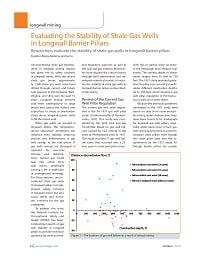Mining Publication: Evaluating the Stability of Shale Gas Wells in Longwall Barrier Pillars
Original creation date: November 2019
Authors: Y Zhang, W Su, J Lu
Unconventional shale gas development in longwall mining regions has given rise to safety concerns in longwall mines. With the recent shale gas boom, approximately 1,500 shale gas wells have been drilled through current and future coal reserves in Pennsylvania, West Virginia and Ohio over the past 15 years. Longwall mining removes coal from underground in large blocks and causes the surface and subsurface to move as overburden strata above longwall panels settle to fill the mined void.
When gas wells are located in longwall pillars, the longwall-induced subsurface movement can influence their stability, inducing stresses and deformations in gas well casings in the coal pillars. If gas well casings are damaged or ruptured by excessive stresses and deformations, natural gas could leak into active longwall mines, potentially causing a fire or explosion in underground workings. For these reasons, unconventional shale gas wells in longwall pillars not only present safety concerns in longwall mines, but also cause safety and economic concerns for the gas companies.
To address this issue, the National Institute for Occupational Safety and Health (NIOSH) has been conducting research on gas well stability in longwall pillars to provide technical guidance for state and federal regulatory agencies as well as the coal and gas industry. Researchers have studied the critical factors through field experiments and developed numerical models to evaluate the stability of shale gas wells in longwall barrier pillars, as described in this article.

- Analysis and Design Considerations for Superimposed Longwall Gate Roads
- Benchmarking Longwall Dust Control Technology and Practices
- Degasification System Selection for U.S. Longwall Mines Using an Expert Classification System
- Development of Stress Measurements and Instrument Placement Techniques for Longwall Coal
- Horizontal Stress and Longwall Headgate Ground Control
- Local Earthquake Tomography for Imaging Mining-Induced Changes Within the Overburden above a Longwall Mine
- Modeling and Prediction of Ventilation Methane Emissions of U.S. Longwall Mines Using Supervised Artificial Neural Networks
- Overview of Coal Mine Ground Control Issues in the Illinois Basin
- Reservoir Engineering Considerations for Coal Seam Degasification and Methane Control in Underground Mines
- Technology News 516 - ARMPS-HWM: New Software for Sizing Pillars for Highwall Mining